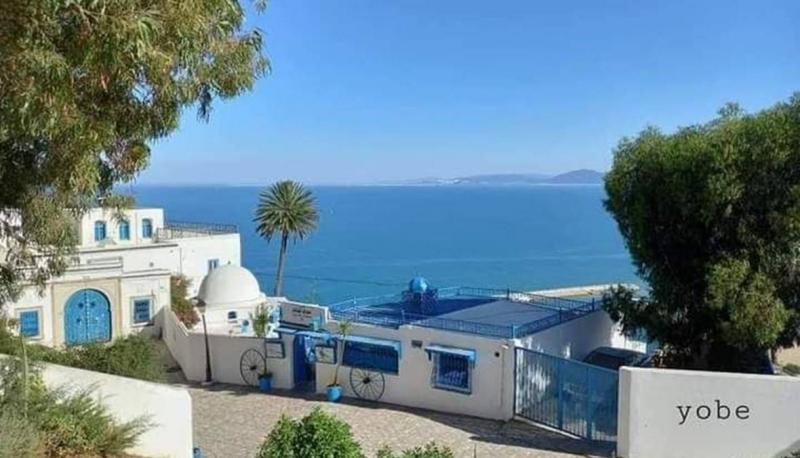The Tunisian town of Sidi Bou Said has been ranked as the third most beautiful town in the world according to "Time Out" magazine and its specialized international statistics website. It is the only town from the Arab and African regions included in this important ranking. The German town of Rothenburg took the first place, while the Indonesian town of Wai Rebo, located on Flores Island, was second. The American town of Carmel in Indiana secured the fourth spot, followed by the Italian town of Alberobello in fifth.
Sidi Bou Said is situated on the northeastern coast of Tunisia, approximately 20 kilometers north of the capital, Tunis. It is famous for its natural beauty and stunning architecture characterized by white and blue colors and traditional Tunisian designs. The town has become one of the tourist destinations that attract visitors from around the world, achieving significant fame over the past decades, drawing not only geographically closer visitors from Arab and European countries but also tourists from the Americas, East Asia, and Oceania.
### Enchanting Landscape
Historically, Sidi Bou Said was called Cape Carthage or Ras Carthage, as it is part of the ancient city of Carthage. However, after the Sufi saint Sidi Abou Said al-Bajli chose the heights of the town for his residence and worship, the town's name was changed to Sidi Bou Said. His shrine and mosque still stand today and have become destinations for worshippers and Sufis, in addition to foreign tourists who have read much about al-Bajli and his extensive knowledge. Remarkably, the late Tunisian President Beji Caid Essebsi was born at this saint's shrine and carried his name.
Sidi Bou Said is renowned for its captivating views of the Gulf of Tunis, which is part of the Mediterranean Sea, formerly referred to as the "Carthaginian Sea" during the peak of the Carthaginian Republic. The town, surrounded by beautiful landscapes characterized by mountains and forests, presents an exceptional artistic tableau where the colors blue and white of the sea, clouds, and buildings blend with the green of tree-covered mountains.
### Cultural Hub
The town comprises a variety of traditional markets, shops, luxury hotels, restaurants, and cafes, with "Café des Nattes" and "Café Sidi Chebaane" being particularly famous. These places reflect Tunisian culture and heritage in architecture and traditional crafts. Sidi Bou Said's rich history has made it one of the global tourist destinations worth visiting for those seeking tranquility, natural beauty, and cultural heritage away from the noise and pollution of major cities.
The late pop king Michael Jackson visited Sidi Bou Said during a historic concert in Tunisia in 1997, and he was so enchanted that he could not believe such beauty could exist in the world, expressing interest in buying a home there. Known for avoiding polluted areas due to health concerns, he found Sidi Bou Said's clean air among the best in the world for a town adjacent to major cities.
### A Place for Art and Thought
Tunisian cultural journalist Samia Harar believes that Sidi Bou Said's advanced global ranking is not solely due to its natural and architectural beauty but also because it is home to musicians, singers, intellectuals, painters, writers, and other famous personalities. For instance, the British baron Dierling, an artist, musician, and collector of Tunisian heritage, built a palace in the traditional Tunisian architectural style here, which has become the center for Arab and Mediterranean music, "Al-Najma Al-Zahra," under the Ministry of Culture.
Among the artists who immortalized Sidi Bou Said are Paul Klee, Auguste Matisse, and Albert Marquet, among others who fell in love with this enchanting town and frequently visited or resided there. Notable writers and historians who have honored Sidi Bou Said include Georges Duhamel, André Gide, Charles Lallemand, and others. Leaders, presidents, and kings from various countries have also visited Sidi Bou Said, drawn by its beauty, charm, and pure air.
Harar points out that the Greek island of Santorini sought to imitate Sidi Bou Said decades ago by painting its buildings white and their doors and windows blue, acquiring permission from Tunisian authorities. However, some in the region attempt to replicate Sidi Bou Said without authorization, hoping to lure tourists, but their imitation has not reached the level of Sidi Bou Said's charm and global radiance.
### Tourist Attraction
Tourism expert Moncef Khmiri notes that images of Sidi Bou Said's alleys and houses have adorned the paintings of many prominent Tunisian and international artists. The view from "Café des Nattes," both inside and outside, has become familiar to many people worldwide, along with the scenic view of Mount Bou Krain and the Gulf of Tunis facing this charming town. The town’s birdcage, inspired by its windows and ancient Carthaginian engravings, is now a trademark of Sidi Bou Said.
Khmiri adds that it is no coincidence that nearly 100,000 visitors flock to Sidi Bou Said daily during the summer and holiday periods to stroll through its alleys, enjoy its fresh spring water, savor coffee while listening to Andalusian music, and admire the breathtaking natural landscapes alongside traditional Tunisian architecture. Visitors also savor local dishes such as fish couscous, octopus couscous, and the delicious "bambalouni" pastry, as well as the town's distinctive traditional sweets.
Khmiri concludes that Sidi Bou Said's selection as the third most beautiful town in the world by a reputable site like "Time Out," without any financial inducements as is common elsewhere, is a natural outcome given the unique characteristics of this beautiful village. This ranking, released during a high season for tourist bookings, will enhance Tunisia's capability to attract tourists, aiming to attract ten million visitors this year.




